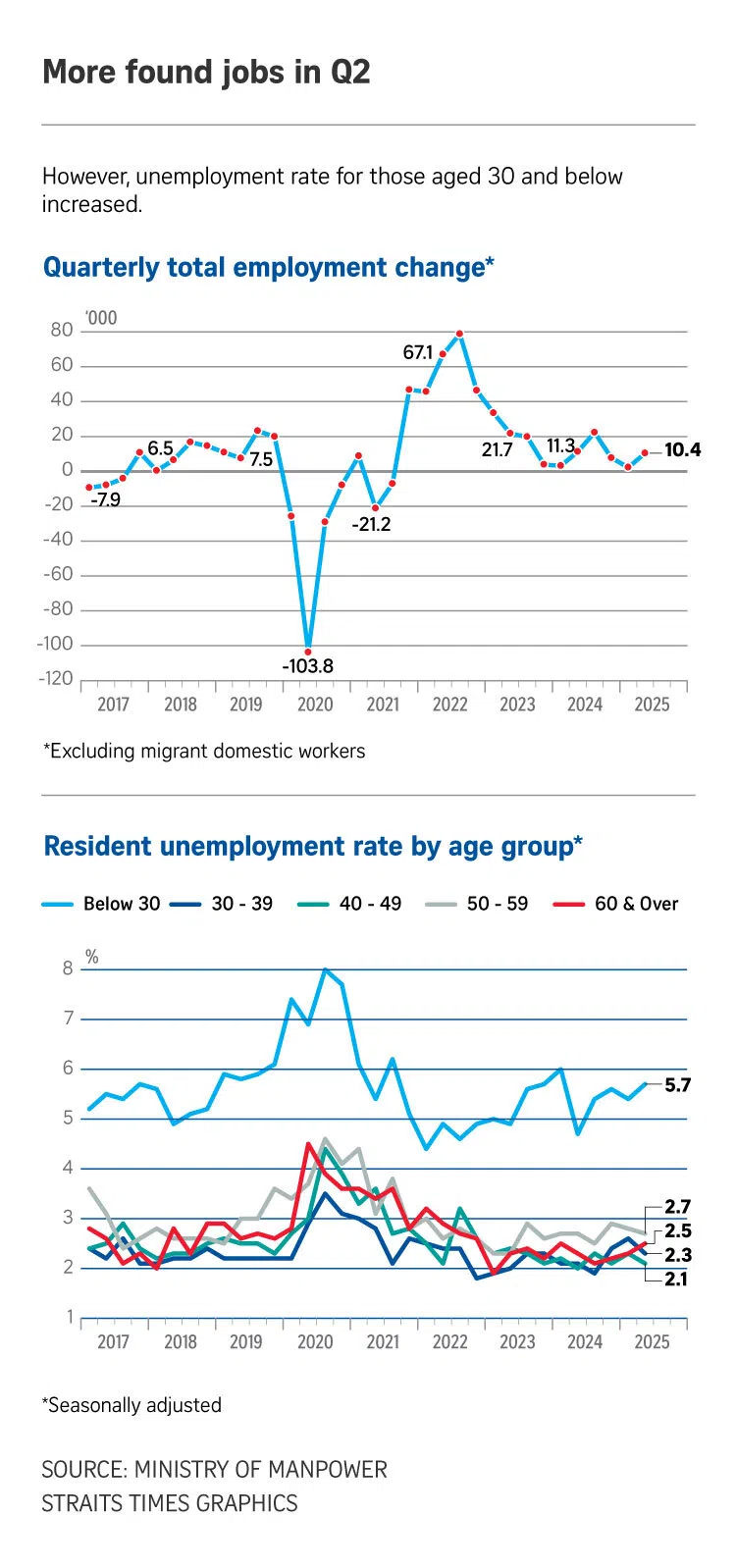MOM says more fresh graduates found jobs in June 2025 than a year ago
Sign up now: Get ST's newsletters delivered to your inbox

As at June 2025, 9,300 fresh resident graduates were employed, for an employment rate of 51.9 per cent.
PHOTO: ST FILE
Follow topic:
SINGAPORE – More students from the 2025 graduating cohort entered the workforce soon after university than the previous cohort, with a lower proportion of them taking a break or seeking further studies.
On Sept 17, the Ministry of Manpower (MOM) released data for fresh graduate employment for the first time, alongside its finalised second-quarter labour market report, amid emerging concerns about a tough job market for new entrants.
As at June 2025, 9,300 fresh resident graduates were employed, for an employment rate of 51.9 per cent – up from 8,600 graduates and an employment rate of 47.9 per cent for the previous cohort.
In a media briefing held during a visit to CapitaLand Group on Sept 17, Minister for Manpower Tan See Leng said a greater supply of fresh graduates amid hiring caution among employers contributed to the tougher job search some face.
“What may not be very evident is, compared to previous years, more fresh graduates... (are) putting off pursuing further degrees,” he said.
There were about 2,400 fewer fresh graduates as at June 2025 who were taking a break or going for further studies, compared with the same time a year ago. And there were about 700 more who were in jobs in June 2025 compared with June 2024.
The additional number of fresh graduate job seekers likely reflects the added pressure to look for a job first, given the economic outlook, Dr Tan added.
MOM also released a list of entry-level professional, managerial, executive and technical roles with the most available openings based on job advertisements as at June, totalling 4,300 jobs.
Overall, there were more than 30,000 entry-level roles available, Dr Tan noted.
Research and development manager was the role in greatest demand with 510 openings.
Building construction engineers, quantity surveyors, research officers, nurses, social workers and software developers were among the other roles with more openings, accounting for nearly 1,700 roles in all.
In the main labour market report, the ministry said more residents – Singaporeans and permanent residents – in the second quarter took longer than six months to land a new job after being retrenched.
The proportion of those who landed a job within six months declined from 60.6 per cent in the first quarter to 56.3 per cent in the second quarter, a similar level to the same period one year ago.
However, more than seven in 10 of those retrenched found work within 12 months for the second quarter, in line with recent results.
“This means that more eventually managed to find work after a longer job search,” MOM said.
Going by age, fewer older workers aged 40 and above found work within six months post-retrenchment. The sharpest decline was observed among those aged 60 and above, from 57.9 per cent in the first quarter to 41.1 per cent in the second quarter.
However, Mr Ang Boon Heng, director of MOM’s manpower research and statistics department, told reporters in a briefing that the pool of retrenched job seekers in a given quarter may be more employable than those in another, giving rise to significant swings.
Instead, it is more useful to evaluate the longer-term trend, he said.
Overall, there were 10,400 more employed people here in the second quarter, comprising 2,600 residents and 7,800 non-residents, up from employment growth of 200 residents and 2,000 non-residents recorded in the first quarter.
Growth in resident employment was led by financial and insurance services, as well as health and social services.
But resident employment declined in the second quarter in the lower-paying food and beverage services, as well as in retail trade.
“Non-resident employment growth was led by work permit holders, in roles such as construction labourers and drivers, which were less likely to attract resident applicants,” MOM said.
However, the ministry said it observed some pockets of softening hiring demand even as overall conditions remained resilient.
Employment fell in outward-oriented sectors such as professional services and in information and communications, it noted.
Nonetheless, employment grew in 112 industries, more than the 87 that saw contraction.

The overall unemployment rate in June 2025 held steady from March 2025 at 2 per cent. But for citizens, it declined from 3.1 per cent to 2.9 per cent, and from 2.9 per cent to 2.8 per cent for residents.
The resident long-term unemployment rate held steady from the first quarter at 0.9 per cent.
Younger residents aged below 30 saw the unemployment rate increase for the first time in 2025, from 5.4 per cent to 5.7 per cent. MOM said this remains within the pre-pandemic range of 4.9 per cent to 6.1 per cent across 2018 and 2019.
However, these young residents were unlikely to be unemployed for long as their long-term unemployment rate declined over the quarter, it added.
The ministry recorded 3,540 retrenchments for the second quarter, similar to the 3,590 in the first.
However, the number retrenched in information and communications increased, from 380 to 500, as did those in financial and insurance services, from 510 to 580.
Residents formed the majority of all retrenched employees in the second quarter at 2,590, or 73.2 per cent. This mirrors the composition of Singapore’s workforce, MOM noted.
Regarding labour turnover, the recruitment rate came in at 1.6 per cent and the resignation rate at 1.1 per cent – both down from the previous quarter.
In a sign of the trade fog bearing down, MOM said larger declines in recruitment rate were observed in outward-oriented sectors such as manufacturing, as well as air transport and supporting services.
Dr Tan also said the upcoming Graduate Industry Traineeships (GRIT) programme is part of a wider framework of support for those struggling to land a job amid increased competition, with the increase in fresh graduates seeking jobs outstripping job growth.
“So, the delta of the 1,700 is what we are trying to address, to tell them that, if they really have the difficulty, why not try (the programme)?”
Dr Tan said the impact of trade uncertainty on the job market will likely occur more in the last quarter of 2025 and first quarter of 2026, which is why the Government has timed the launch of GRIT for October, with “drawer plans” at the ready if the situation worsens.
He was visiting CapitaLand to observe how the real estate developer and manager is integrating artificial intelligence (AI) into the work of employees to raise productivity.
CapitaLand is committed to set aside up to $7 million over three years to build AI proficiency and increase global exposure of its workers, among other things, under a memorandum of understanding it signed with Workforce Singapore on Sept 17.


